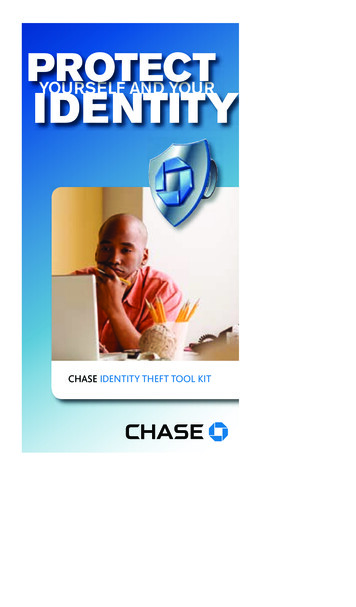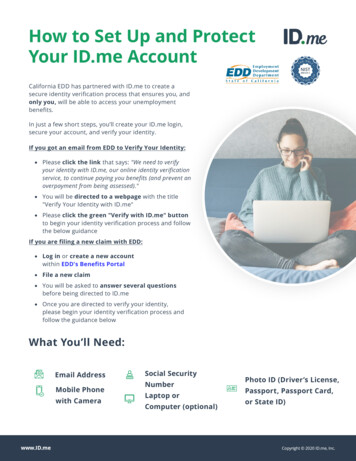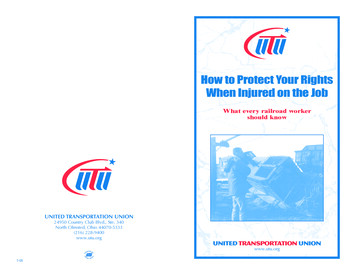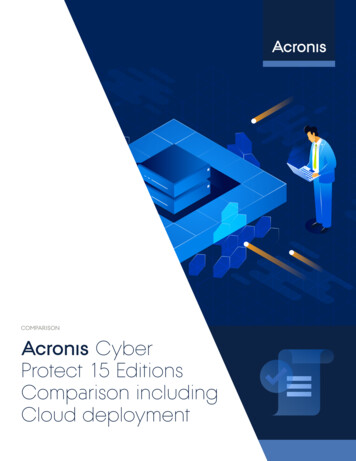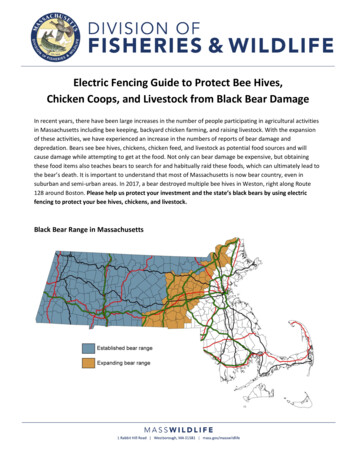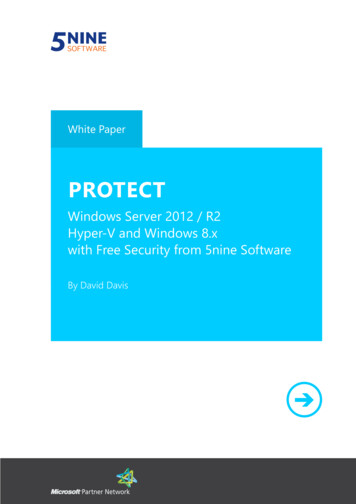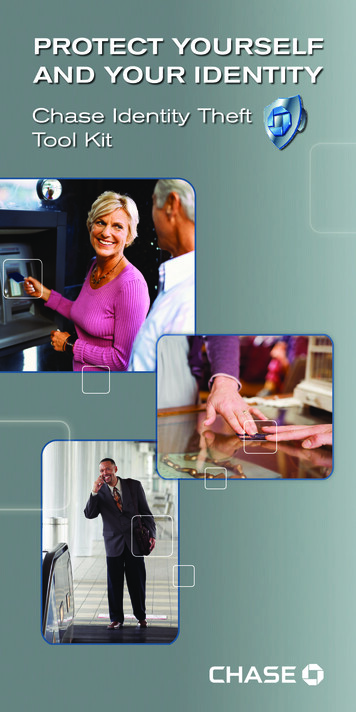
Transcription
PROTECT YOURSELFAND YOUR IDENTITYChase Identity TheftTool Kit
USE THESE IMPORTANT CONTACTS TOKEEP YOURSELF PROTECTEDCHASE CONTACTSCustomer Protection GroupCredit Cards1-888-745-0091Other Account Inquiries:Debit Cards1-800-935-9935Deposit Customers1-800-935-9935Mortgage Customers1-800-848-9136Auto Loan Customers1-800-336-6675Auto Lease Customers1-800-227-5151Brokerage Clients1-800-392-5749Education Financing1-800-489-5005Home Equity Loan or Line of Credit 1-800-836-5656www.chase.com/identitytheftCREDIT REPORTING AGENCIESRemember, you’re entitled to a free credit reportevery year from each of the three major creditreporting agencies. Request yours today. More infois available at xperian1-888-397-3742TransUnion1-800-680-7289
OTHER IMPORTANT CONTACTSFederal Trade Commission Identity TheftInformationTo learn more about identity theft, visit theFederal Trade Commission consumer website atwww.ftc.gov/idtheft, or call 1-877-ID-THEFT.United States Postal Serviceonline at https://postalinspectors.uspis.govU.S. Secret ServiceFind a field office near you at www.secretservice.govSocial Security NumberFraud Hotline1-800-269-0271Social Security Department1-800-772-1213Lost or Stolen Passports1-877-487-2778Protect Yourself andYour Identity3
At Chase, we work hard to providecustomized tools and information to helpprepare you for whatever happensin your evolving financial life.We’ve prepared this guide to help you defendyourself against identity theft. Use it to learnmore about identity theft and the choices youcan make to better protect yourself.4
WHAT IS IDENTITY THEFT?Identity theft happens when a criminal obtainsyour personal information to steal money fromyour accounts, open new credit cards, apply forloans, obtain services, and commit other crimes —all using your identity. These acts can damageyour credit, leave you with unwanted bills andcause you countless hours and frustration toclear your good name.This guide will help you understand identitytheft and how to protect yourself from it. If you’vealready been a victim of identity theft, we’ll giveyou an action plan to help you recover fromidentity theft. We’ll give you personal attentionand work with you every step of the way.We’ll also assist you as you work with creditreporting agencies and other key agencies.Protect Yourself andYour Identity5
DEALING WITH IDENTITY THEFTAny time you think your identity has been compromised,be sure to contact the Customer Protection Group Call1-888-745-0091.If you’ve been a victim of identity theft, use this planof action to recover from identity theft: ontact the fraud departments of the three majorCcredit bureaus (Equifax, Experian and TransUnion) –They maintain reports that track the credit accountsopened in your name. R equest a consumer statement (victimstatement) on your credit report that alertscreditors to call you before opening a newaccount or changing your existing accounts.You can attach up to 2 contact phone numbersand you can remove an alert at any time.There are three types of alerts:- An Initial Alert remains on file for 90 days(a decline remains on file for 90 days).- An Extended Alert requires a lawenforcement report and remains on file for7 years (a decline remains on file for5 years).- An Active-Duty Alert is available to membersof the military currently on active duty andremains on file for 1 year (a decline remainson file for 2 years).6
You should call first and then follow up in writing whenrequesting alerts. See the sample credit reportingagency letters in the Sample Documents section. A s a consumer, you’re entitled to one free creditreport every year from each of the three majorcredit reporting agencies (Equifax, Experian andTransUnion). Review your credit reports carefullyand make sure that no additional fraudulentaccounts were opened or unauthorized changeswere made. C heck the inquiry section of your credit report.When inquiries appear from companies thatopened fraudulent accounts, request that theinquiries be removed from your report. Thenfollow up with the credit reporting agenciesand any associated financial institutions.Contact your local police –File a report with your local police or the police in thecommunity where the identity theft took place.A copy of the police report can help provide evidenceof fraud to creditors. If the police cannot file a report,request that a miscellaneous incident report befiled. Remember an Extended Alert requires a lawenforcement report.Protect Yourself andYour Identity7
Perform periodic reviews to ensure accuracy – R eview all accounts including credit card, bank,and utilities. I mmediately report accounts that have beentampered with to the appropriate creditor,bank or utility. To contact the State PublicUtilities Commission go towww.fcc.gov/wcb/iatd/state puc.html C lose accounts that have been tampered with andopen new ones with new PINs and passwords.Avoid using easily available information as apassword such as a birthday, Social SecurityNumber, or mother’s maiden name. I f your checks were stolen or misused, close theaccount. Also, alert the major check verificationcompanies that you may be a victim to help themprevent further fraudulent use of your identity.TeleCheck: 1-800-710-9898Certegy: 1-800-437-5120 I f an identity thief has established a new phoneor cellular service in your name, contact yourservice provider immediately to cancel theaccount. If you have trouble getting fraudulentphone charges removed from your account,contact the State Public Utilities Commissionfor local service providers or the FederalCommunications Commission(1-888-CALL-FCC) for long distanceservice providers.8
I f you believe someone is using your SocialSecurity Number to apply for a job, contactthe Social Security Fraud Hotline. Verify theaccuracy of the earnings reported on your SocialSecurity statement by contacting the SocialSecurity Administration at 1-800-772-1213. I f you suspect your name is being used by anidentity thief to get a driver’s license or ID card,or if your driver’s license has been lost or stolen,contact your local Department of Motor Vehicles.Protect Yourself andYour Identity9
Evaluate and protect your computer –I f you identify hacking (the installation ofmalicious programs) or a computer virus alertthe appropriate authorities by contacting:1. Y our Internet Service provider. The emailaddress of a Internet Service provider canusually be found on their website.2. The FBI at www.ic3.gov.I f you are a victim of Internet Fraud reportit to the Federal Trade Commission,at www.ftc.gov/complaint. The FTC enterscomplaints into a secure, online databaseavailable to hundreds of civil and criminal lawenforcement agencies in the U.S. and abroad.If you get deceptive emails, including emailsasking for your personal information, forward it to:1. s pam@uce.gov. Be sure to include as muchinformation as possible.10
2. r eportphishing@antiphishing.org.The Anti-Phishing Working Group, is aconsortium of Internet Service Providers,security vendors, financial institutions and lawenforcement agencies.I f you have mistakenly given your personalinformation to a fraudster, file a complaint atwww.ftc.gov/complaint, and then visit the FederalTrade Commission’s Identity Theft website atwww.ftc.gov/idtheft to learn how to minimize yourrisk of damage from a potential theft of your identity.If you are suspicious about something on a socialnetworking site, report concerns to the socialnetworking site. Most sites have links whereusers can immediately report abusive, suspicious, orinappropriate online behavior.Check mail carefully –If you receive statements for accounts for whichyou did not apply, contact the creditor. If you don’treceive statements for any of your usual accounts(including credit, banking and investment), contactthe company immediately. If you don’t receive mailyou usually receive, contact the postmaster at yourlocal post office. An identity thief may have falsifieda change of address to redirect your mail to adifferent location.Protect Yourself andYour Identity11
SAMPLE DISPUTE LETTERSIf you’re in the process of resolving identity theft and want tosubmit a dispute, use these proven letters as templates whencorresponding with credit reporting agencies and credit cardissuers. Be sure to provide the facts in a clear and concisemanner and follow the other tips located in the Dealing withIdentity Theft section.Credit Reporting AgencyDateYour NameYour AddressYour City, State, ZipComplaint Dept.Name of Credit BureauAddressCity, State, ZipDear Sir or Madam:I am writing to dispute the following information in my file.The items I dispute are circled on the attached copy ofthe report I received. (Identify item(s) disputed by name ofsource, such as creditors or tax court, and identify type ofitem, such as credit account, judgment, etc.)This item is (inaccurate or incomplete) because (describewhat is inaccurate or incomplete and why). I am requestingthat the item be deleted (or request another specific change)to correct the information.Enclosed are copies of (use this sentence if applicableand describe any enclosed documentation, such aspayment records or court documents) supporting myposition.Please investigate this (these) matter(s) and (delete orcorrect) the disputed item(s) as soon as possible.Sincerely,Your NameEnclosures: (List what you are enclosing)12
SAMPLE DISPUTE LETTERSCredit Card IssuersDateYour NameYour AddressYour City, State, ZipComplaint Dept.Name of Credit BureauAddressCity, State, ZipDear Sir or Madam:I am writing to dispute a billing error in the amountof on my account. The amount is inaccuratebecause (describe the problem). I am requesting that theerror be corrected, that any finance or other chargesrelated to the disputed amount be credited as well, andthat I receive an accurate statement.Enclosed are copies of (use this sentence to describe anyenclosed information, such as sales slips or paymentrecords) supporting my position.Please investigate this matter and correct the billing erroras soon as possible.Sincerely,Your NameEnclosures: (List what you are enclosing)Protect Yourself andYour Identity13
UNDERSTANDING IDENTITY THEFTHow Identity Theft HappensNo matter how careful you are about protecting yourpersonal information, no one is completely safe fromidentity theft. Thieves can obtain your personalinformation in many ways.In today’s Wi-Fi, Internet-ready world, every websiteyou establish an account with and every social mediasite you use could be a potential risk.That’s why it’s so important to understand howidentity theft happens.Through Your Computer and the InternetPhishing (pronounced “fishing”) — You receive anemail — which appears to be from a reputablecompany, asking you to respond or go to a websiteand provide your personal information. Theseemails may also contain fraudulent phone numbersto call to provide personal information – called“vishing.” Remember, no legitimate representativeof JPMorgan Chase will ever ask you for your PIN orpassword via email communication. They will requestthis information when you call in to discuss youraccount.Spoofing — Setting up a bogus website thatlooks like a legitimate site and asks you to providepersonal information.Pharming — Redirecting your browser’s requestfor a legitimate website to a bogus location thatresembles it in order to collect your personalinformation.Hacking — Using techniques to install maliciousprograms on your computer. The programs thencapture your keystrokes and network traffic in14
order to steal personal information, includinguser IDs and passwords.Stealing your laptop or smart phone — To useany unsecured data to discover passwords andaccess accounts.Through Your Mail and Personal DocumentsStealing wallets and purses containing youridentification, credit and bank cards.Taking your mail, including bank and credit cardstatements, pre-approved credit offers, telephonecalling cards and tax information.Completing a “change of address form” to divertyour mail to another location.Rummaging through trash for personal data in apractice known as “dumpster diving.”Obtaining your credit report by posing as someonewho may have a legitimate need for and a legal rightto the information.Finding personal information in your home.How Identity Thieves Use Your Personal InformationThey can call your credit card issuer pretending tobe you, and change the mailing address on yourcredit card account, then run up charges on youraccount. Because statements are sent to the newaddress, you may not realize there’s a problem.Thieves can open a new credit card account usingyour name, date of birth and Social Security Number.When they use the credit card and don’t pay the bills,the delinquent account is reported on your credit report.They can establish phone or wireless service oropen a bank account in your name, forge counterfeitchecks or debit cards. They can even buy cars bytaking out auto loans in your name.Protect Yourself andYour Identity15
HOW TO PREVENT IDENTITY THEFTAt Chase, we’re committed to working with you toprotect your personal information. We believe thatone of the best ways to fight identity theft is toprevent it from happening in the first place. Here aresome easy things you can do to prevent someonefrom stealing your information.Carry only what you need.The less personal information you carry, the betteroff you will be if your purse or wallet is stolen. Forexample, carrying your Social Security card with youis rarely necessary. Reminder: certain medical cardshave your Social Security Number on them.Don’t put outgoing mail in your mailbox.Drop your mail into a secure, official Postal Servicecollection box.Report lost or stolen credit cards and checksimmediately.Review your account for unrecognized or counterfeitchecks. Make sure the checks that clear the bankwere written by you. Also,
Chase Identity Theft Tool Kit. CHASE CONTACTS Customer Protection Group Credit Cards 1-888-745-0091 Other Account Inquiries: Debit Cards 1-800-935-9935 Deposit Customers 1-800-935-9935 Mortgage Customers 1-800-848-9136 Auto Loan Customers 1-800-336-6675 Auto Lease Customers 1-800-227-5151 Brokerage Clients 1-800-392-5749 Education .
